
Where to start? Well I received these boots almost exactly a year ago. Since then I've tested them on everything and I really do mean everything: WI6, Scottish tech 8, loads of winter alpine routes from hard technical pitches to 'romping' terrain, 6 weeks in Alaska, and plenty of skiing. So I think I've covered just about everything you can possibly do with a boot. Overall verdict? Brilliant.
The Spantik is a double boot, meaning that you have an inner and an outer. The advantages of this are two-fold. Firstly you have twice the insulation, and secondly they are much quicker to dry, which is crucial if you are doing multi-day routes and bivying at night. The outer shell is of a 5 layer construction: the key layers being the high density polythene barrier and the thermo-reflective aluminium layer. The design crux here is to create an outer shell with high insulating and waterproof properties, which also has the flexibility of a summer boot and lets your feet breathe.
"...The lacing system on the outer is pretty ingenious. A one lace system with no need for tying any knots so you don't have to take your gloves off..."
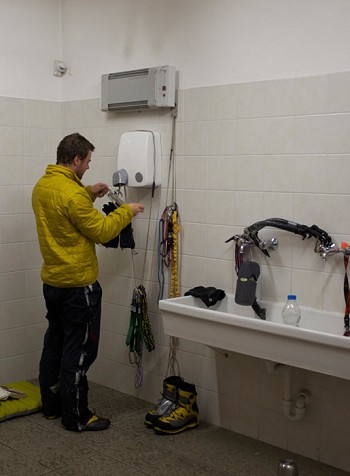
The sole of the boot is often overlooked by climbers but is actually maybe the most important thing when it comes to insulation. The highest heat loss is actually through the sole. The easy way to combat this is to put on a nice thick layer of insulation underneath: of course the downside of this is that you lose precision and sensitivity through the boot. The thinner the sole the better it will be for technical climbing. The Spantik uses a 4 layer construction including a thin carbon fiber layer topped off with the tried and tested Vibram sole. Incidentally the Spantik uses the more nimble Nepal Evo sole, which accounts for some of the shedding of weight on the old Nuptse.
The lacing system on the outer is pretty ingenious. A one lace system with no need for tying any knots. As this is a winter boot it makes sense to have a system where you don't have to take your gloves off. It's easy to execute but hard to explain so I'll just leave it as that. The only downside is that the lace supplied is very thin and mine has snapped in the past. I simply replaced it with a thicker one which does the job just as well.
The inner boot is maybe the best part of the whole boot. It's incredibly well designed. This is no scrimpy little foam insert here but a well constructed insulated liner. It features 6 layers, from the outside:
- Lorica durable, water resistant
- Netting - anti-abrasion
- Polythene and aluminium - reflects radiated heat
- 4mm foam - insulating layer
- Polyamide - insulating layer
- Mesh - to aid rapid moisture evaporation from the foot
It's also incredibly comfortable. The inner and outer are meant to work together as a dual insulating boot. Instead of just a foam inner this a almost a completely separate boot: it is constructed to fit the foot snugly with padding just where you need it for support around the ankles. It is a fully insulated boot as well and has an exterior anti-abrasion liner which actually works amazingly well.
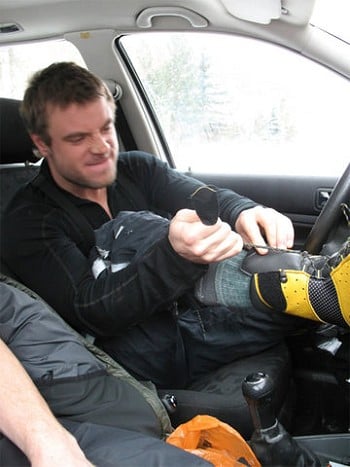
After using these boots for probably over 150 mountain days they still look brand new and feel it as well. The lacing up system is also based on the same ideas as the outer and once 'set up' for your foot size is incredibly quick to do up utilising a Velcro system instead of tying a knot. The fit is great on the inner and due to the Overlap System on the outer boot, which allows you to effectively open the top of it gaping wide, you can slip the inner in with ease (not always the case with double boots).
There were reported issues with the eyelets snapping on both the outer and inner boot but I can't say that this has happened to me. I believe that this was a teething issue with the first versions of the Spantiks but is an issue that has now been resolved.
"...Every extra lb on your feet is the equivalent to carrying an extra 6lb on your back so it's worth being anal about..."
Now to the meat of the test. Out on the hills they were pretty out of this world. Firstly you don't get cold feet in these boots. You just don't. I suffer from cold feet quite easily so this was a nice surprise: at the end of the day winter alpinism is miserable, and is made even more so with freezing toes. Their dexterity on waterfall ice was great too: obviously you can opt for a lighter boot still for water ice days but I found that they were no issue on some of the harder ice climbs that I did last year.
Their performance on mixed was great too, again very similar idea to ice but I climbed quite a few Scottish climbs that Bullock et al put up in Argentiere last winter up to Scottish tech 8 and found them to be a great balance between good support and precision. You'll never have the sensitivity of a lighter single-boot boot and these are way over the top for Scottish winter obviously but they are great for Alpine mixed.
As for their overall performance this last year it has been awesome. On big Alpine winter routes they have been a real joy to climb in. For a double boot they are incredibly light at 2.2kg (size 42). Boot weight might not seem like a big deal but according to a scientific study every extra lb on your feet is the equivalent to carrying an extra 6lb on your back so it's worth being anal about. Until the Scarpa 6000 came out these were the lightest in their class by a long shot. Coupled with a pair of ultra light pair of Darts it makes for a great combo and one that will have you running up north faces in no time.
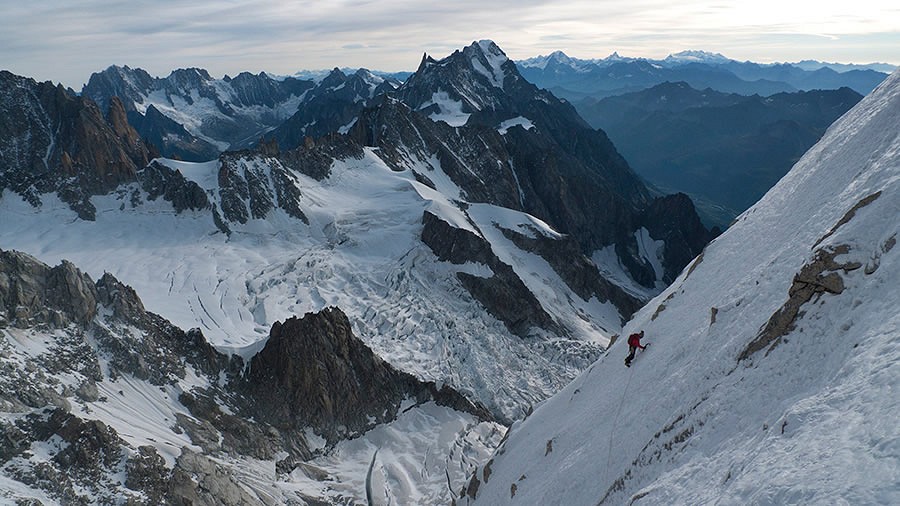
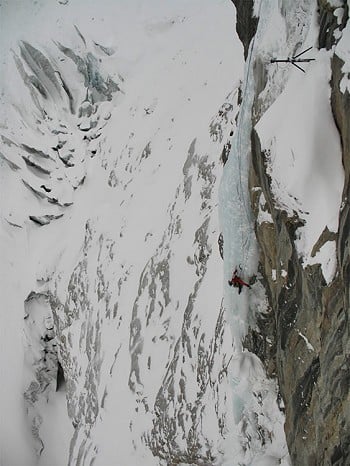
As well as climbing in the Spantiks I've also done a lot of ski days in them; both in my big powder skis and my small approach skis. I first tried skiing in climbing boots two years ago and couldn't hack it at all in my Phantom Lites. From afar it must have looked hilarious. This winter I decided to really teach myself how to do it and spent a fair portion of it whizzing about the Alps in my Spantiks and 130cm skis. At first it's a bit weird but the support offered by the Spantiks was just right and by the end it was more fun than skiing in my proper set up.
Some boots don't quite offer enough support on the shins which makes skiing very hard and allows for a high ankle snapping potential but the Flex OverLap system on the Spantkis really helps support the front of the boot onto your shins. The boot also fits fine in Fritschi touring bindings without having to do any modifications to the sole.
I got the chance to use these on an expedition, which opens up a whole new world of testing. When you have to live in a pair of boots on a glacier you really appreciate whether they are comfy or not. The outer boot is a very sturdy shell, which means that you can just wear them outside the tent on their own without having to deal with the inners. Obviously you don't want to walk too far in them as they'll be a very loose fit but it's great for doing your business outside the tent: that includes collecting snow, digging the tent out etc rather than just the obvious one!
"...The Spantiks, while being amazing boots,
did have their faults as well..."
All said and done though nothing is perfect. The Spantiks, while being amazing boots, did have their faults as well. They don't fit all models of crampons. This is an issue that most boots of this ilk face, but if you are dead keen on a specific pair of crampons then it's worth making 100% sure that they fit perectly. The popular Grivel G14s for example did not fit but Petzl-Charlet Darts (you can see these in the first picture) fit well. Boot and crampon compatibly can be complex, and crampon adjustment and boot size all play a part. Spantiks are a fairly new design so it's most likely that compatible fitting crampons will also come from newer designs of crampon. Try various crampons before you buy.
In addition, while the fit of the boot was brilliant, from the start I found that my shins got ripped apart when touring with a sled: uber Alaskan Alpinist Mark Westman also had this problem, but others may not. I didn't find blisters a problem when actually climbing in them but we had to take a few days off at one point in Alaska to let the shins heal after resupplying ABC.
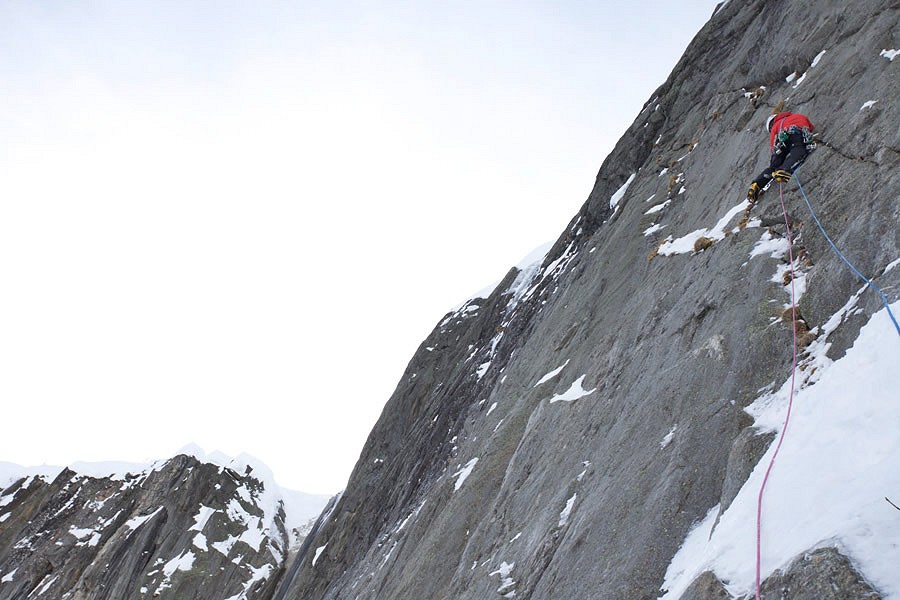
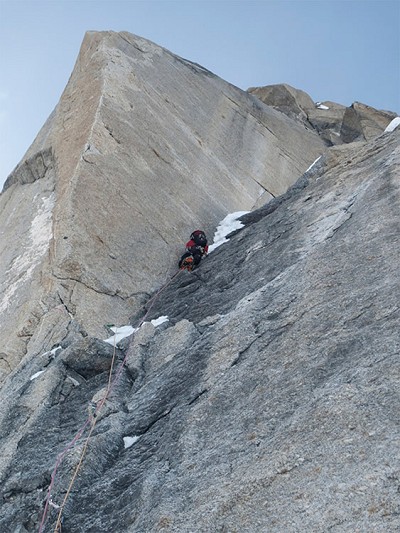
Overall, and in comparison to the Scarpa 6000
So overall I am a big fan of the Spantiks as you can tell. They were pretty ground breaking when they were introduced four years ago and they are still to be found on the feet of many of the world's top Alpinists. This year though the new Scarpa 6000 came onto the scene and became the closest I can think of as a competitor. I've not had a chance to climb in the 6000ers but my climbing partner has a pair so we've been able to compare quite a bit. The good news is that the boots are actually very different so you've got a choice depending on your focus.
The Spantiks are a durable double boot that offer a supportive feel but without the excess weight that other boots in its class do. The Scarpa 6000 boots are quite a different affair when you look into it. They are a much narrower and lighter boot whilst still in the same warmth category. The narrowness of the boot and a thinner sole are an obvious advantage in that it will be better for climbing harder technical stuff. The 200g saving per pair is obviously quite a bonus as well. However it offers less support than the Spantik due to its outer shell.
"...They were pretty ground breaking and they are still to be found on the feet of many of the world's top Alpinists.."
The inner is a far more lightweight affair compared to the Spantik inner and will not last anywhere near as long. However you have to remember that this boot was deisgned by Ueli Steck, so it is designed for the light and fast ethic. He told me that they had designed an even lighter version of the 6000 that was amazing but so flimsy that it wasn't viable commercially as it wouldn't last. So I guess that the 6000 is the closest they could make right now to a super light boot that wont fall apart after a month. The Spantik is definitely more robust and there is no doubt that it will last far longer than the 6000. It also seems a fair bit warmer than the 6000 but I cannot say 100% for sure.
I suspect that the 6000 is going to be a more pleasurable boot for technical ascents and for cold ice climbing areas but for big mountain routes the Spantiks gains the upper edge for warmth and with extra foot support for big ice fields (think about being on your front points for hours on end and you get the idea). This was especially brought home to me on the Colton Macintyre on the Grandes Jorasses last week when my partner's calves and achilles were screaming and mine were fine. This is by no means a complete comparison between the two but merely an overview as this will no doubt be of interest. However the key thing here is that really they aren't the same boot: if you want something light and technical then the 6000 is the better choice but if you want a more robust boot for the big mountains with a bit more support for romping up ice fields and skiing in then the Spantik would be the winner.
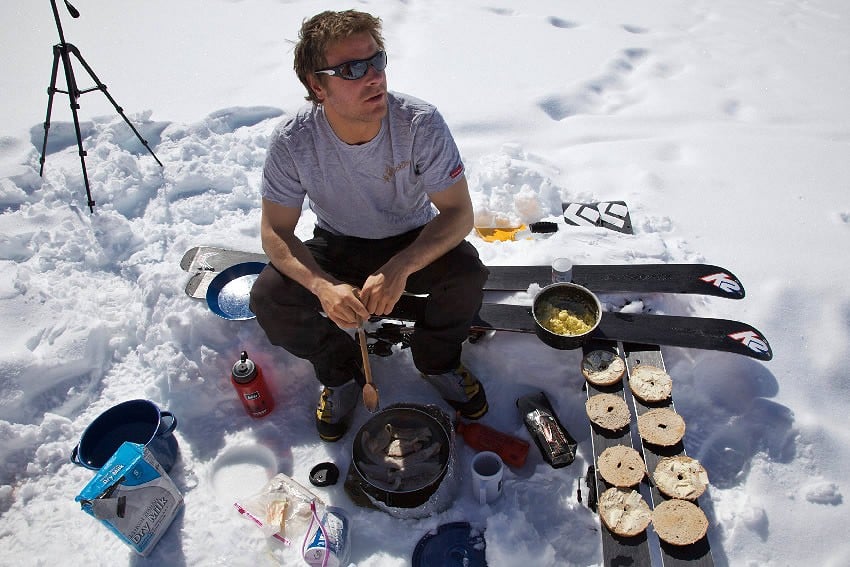
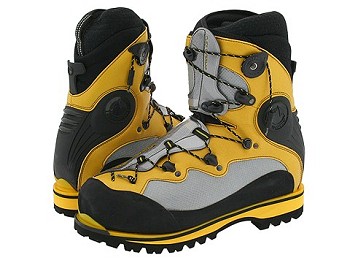
La Sportiva Spantik
- WEIGHT: 44.48oz/1261g
- LAST: Nuptse CONSTRUCTION
- OUTER: Board Lasted
- INNER: Slip Lasted
- OUTER BOOT: PU-Tech transparent PU-coated embossed Benecke CeraCom® PUR leatherette/ Water-repellent Lorica® with Antiacqua™ external coating/ Vibram® rubber rand/ Molded TPU ankle backstay reinforcement/ PE micro-cellular thermal insulating closed cell foam lined with a thermo-reflective aluminum facing coated with an anti-abrasion flockingcoated with an anti-abrasion flocking.
- INNER BOOT: Micro-perforated thermo-formable PE/ Water-repellent Lorica® with Antiacqua™ external coating INSOLE: 5mm thermal structure carbon fiber and aluminum insulation.
- MIDSOLE: TPU/ Dual-density Micropore
- EVA SOLE: Vibram® Montagna
- SIZES: 39-47 (half sizes)
PRICE: £480
MORE INFO: on the La Sportiva Website.
About Jon Griffith

Jon Griffith's first climbing days were in the Avon Gorge at Bristol. After university he moved to Chamonix, where he works as a professional mountain photographer: www.alpineexposures.com.
"It's hard to pick one specific type of climbing that I prefer over the others but I think my heart still lies with big mixed alpine routes that potentially involve a couple of nights bivying. I am still getting used to the whole Chamonix 'get back in time for the last lift' style - I still include bivying as a part of any decent mountaineering experience. I am also still getting used to crack climbing - it hurts.... a lot."



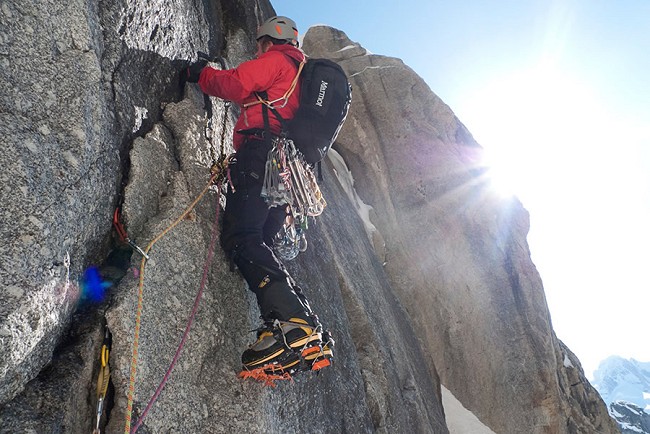








Comments